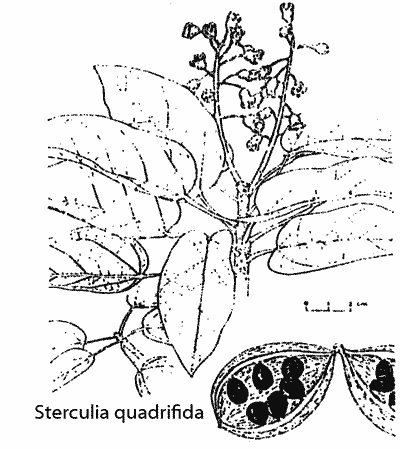
FOOD FROM THE BUSH - PEANUT TREE
SCIENTIFIC NAME: Sterculia quadrifida
FAMILY: Sterculiaceae
The common names known for this are Peanut tree, Red Fruited Kurrajong, and Koralba. Other varieties are S. shillinglawii and S. laurifolia.
A genus of around about 300 species world wide, of which there are 5 mainly native to Australia. Sterculia was named by the Swedish botanist, Carl Linnaeus (1707-1778), after the Roman God of manure heaps, Sterculius. It refers to the rancid smell of the flowers and leaves of certain species.
The quadrifida is a beautiful and often bushy tree, with light green egg- to heart-shaped leaves, 5-15cm in length. Unlike some of the other species, the quadrifida has small cream to white lemon-scented flowers which are arranged in numerous short racemes, containing both male and female flowers.

These flowers, however, are not as conspicuous as the fruit. Brilliant orange to firey-red, leathery pods hang in clusters along the many branches. They ripen from November through to late January. The fruit splits to reveal several seeds with a satin black coating. The shell is rubbed off and the seed eaten either raw or roasted.
It grows naturally from north-eastern NSW, through to Queensland to New Guinea and Northern Territory, also Western Australia. Though it does require excellent drainage, it will tolerate most soils, growing 6-18m, depending on the favourability of these conditions. It is almost deciduous in the winter months and does not like heavy frosts.
The timber is white to light grey, soft, light and easily worked, suitable for crafting toys, models and boxes. The trunk is normally buttressed. The Aborigines used to use fibres from the bark for making kangaroo nets. They also used the leaves for the treatment of wounds and stings. Young trees can be grown in full sun to filter shade and can resist moderately strong winds once established.
Common Names: Peanut tree, Red Fruited Kurrajong, Koralba.
Other species: S. shillinglawii, S. laurifolia.
Quite worthy of trial in your garden or orchard, with fruits tasting between a cashew and a pine nut, and once roasted, crushed and sprinkled over ice cream, is not a bad treat on a hot summer's day.
DATE: November 1992
* * * * * * * * * * * * *
